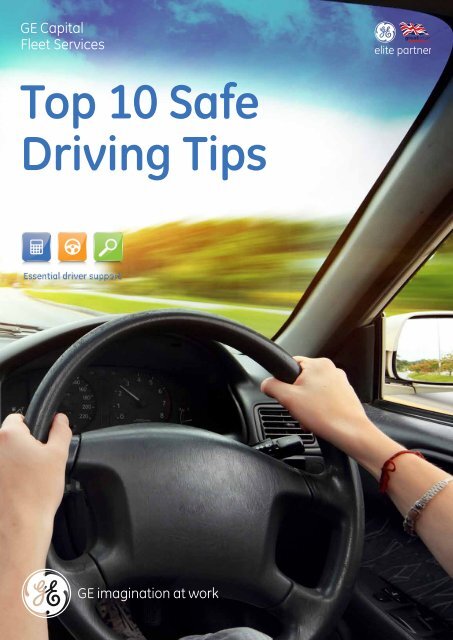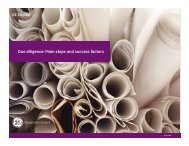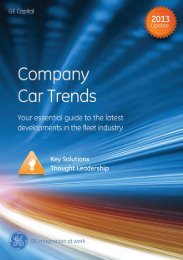Top 10 Safe Driving Tips - GE Capital UK
Top 10 Safe Driving Tips - GE Capital UK
Top 10 Safe Driving Tips - GE Capital UK
Create successful ePaper yourself
Turn your PDF publications into a flip-book with our unique Google optimized e-Paper software.
<strong>Top</strong> <strong>10</strong> <strong>Safe</strong><br />
<strong>Driving</strong> <strong>Tips</strong>
<strong>Top</strong> <strong>10</strong> <strong>Safe</strong> <strong>Driving</strong> <strong>Tips</strong><br />
<strong>Safe</strong> driving doesn’t happen automatically.<br />
The Transport Research Laboratory will tell you that most drivers only concentrate for 25% of their driving time – that<br />
means 3 out of 4 drivers around you are not paying attention to the driving task but are being distracted by<br />
something else. Distraction is particularly common for business drivers and the risk of being involved in an accident is<br />
40% greater if you are driving on business.<br />
Distracted drivers are failing to identify the hazards and are missing or ignoring the clues – you have all seen the<br />
driver holding a phone, yawning, or not generally paying attention.<br />
Spotting the distracted driver is the first step towards removing yourself from danger.<br />
Following these tips is a great start on the road to becoming a safer driver.<br />
1. Keep your distance<br />
You can’t crash into space! The more space you keep around you, the less risk of a collision.<br />
Rear-end collisions are one of the most common forms of traffic accidents – but you don’t have to be a victim.<br />
Managing the space of the driver behind you is just as important as the space in front of you and you may well need<br />
to build into that space, the braking distance of the driver who is too close behind.<br />
When stopping, the early use of brake lights to control the attention and slowing of the driver behind you may well<br />
prevent a shunt from behind – so effective is the technique that the latest models of cars flash your brake lights if you<br />
brake hard and even flash the hazard warning lights when braking extra hard.<br />
Only a fool breaks the 2 second rule.<br />
At a minimum, during dry weather conditions, you should have at least 2 seconds of space between you and the<br />
vehicle in front of you. When visibility is low such as during light fog, light rain or night-time driving, you should double<br />
the following distance to a minimum of 4 seconds and in severe weather conditions such as snow and ice, then<br />
double the distance again.<br />
Always leave a way out.<br />
Remember to keep space to the sides of your vehicle and avoid wherever possible driving directly alongside another<br />
vehicle, especially if that places you in the blind spot of the other driver, for example a truck. Can the other driver see<br />
you? A good indication is whether you can see him in his mirrors.<br />
If someone pulls up beside you and matches their speed to yours, adjust your speed slightly to create space next to<br />
you. That way, if the need arises for avoidance, you have already built an escape route out of trouble.
2. More haste less speed<br />
In busy congested conditions or in built-up areas give yourself time. There’s no need to speed and you won’t get<br />
there any quicker.<br />
In 20<strong>10</strong>, 40% of all road-traffic fatalities happened in built-up areas compared to only 6% on motorways*. 75% of all<br />
traffic accidents happen in town where there are generally more hazards per mile.<br />
The risk of fatality in your car is dependent on collision speed – a rear end shunt on the motorway is unlikely to be<br />
serious if the collision speed is low, but hitting a child, a pedal cyclist or a motorcyclist even below the urban speed<br />
limit can be fatal for them.<br />
Don’t treat speed limits as a target and ensure you are constantly taking road and traffic conditions into account.<br />
Keeping your speed and distance means that hazards are more likely to dissolve ahead of you and you won’t fall foul<br />
of harsh acceleration and braking (which will also save your fuel too). Pay extra attention where there are junctions,<br />
traffic lights and pedestrian crossings. In particular, try to anticipate what pedestrians and cyclists might do. If<br />
pedestrians, particularly children, are looking the other way, they may step out into the road without seeing you.<br />
Knowing that you have plenty of time to complete your journey will help you to relax and avoid the temptation to<br />
push your speed.<br />
* Department for Transport – Road casualties Great Britain 20<strong>10</strong><br />
3. Look ahead and anticipate<br />
Don’t just look at the vehicle in front and in your mirror to observe what is going on immediately around.<br />
Anticipate what is happening ahead of you by looking at the furthest point along the road as well as observing<br />
the behaviours of your fellow road users.<br />
One of the main causes of accidents is the failure to recognise a hazardous situation. If a driver fails to see the<br />
possible danger, he or she cannot take steps to avoid it. The average driver reacts to an expected event in 0.7 of a<br />
second – and up to three times longer when the event is unexpected or the driver is distracted. This means that it can<br />
take up to 2.5 seconds for a driver to see what is happening and then decide on a reaction – all this and then the<br />
overall stopping distance of the vehicle needs to be taken into account*.<br />
Satnavs are fast becoming a major cause of driver distraction where the driver often blindly follows instructions<br />
rather than anticipating the road ahead. What you see takes priority over what the satnav says. We’ve all heard the<br />
stories of people being stuck in narrow lanes, driving into rivers and directed into oncoming traffic. If the road looks<br />
wrong, don’t take it.<br />
* The Institute of Advanced Motorists
4. Think F.L.O.W.E.R<br />
Ensuring that your vehicle is serviced regularly (in line with the manufacturers recommendations) will help to<br />
avoid breakdowns and accidents caused by vehicle faults. To ensure safety for both yourself and those around<br />
you and to keep your vehicle running smoothly, remember FLOWER:<br />
Fuel – Play safe and stay topped up.<br />
Lights – Regularly check main beams, indicators, fog lights, sidelights and brake lights.<br />
Oil – Over-filling or under-filling the oil risks engine damage.<br />
Water – Keep the screen wash reservoir full and use plenty of additive in winter, BEFORE it freezes up.<br />
Electrics – Check battery, wiper blades, electric windows, horn and heater fan. Defects will only worsen<br />
if neglected.<br />
Rubber – The safety implications of under-inflated tyres include the increased risk of suffering a blow out at<br />
high speed due to excessive heat building up in the tyre. The legal limit for minimum tread depth on your tyres is<br />
1.6 millimetres, across the central ¾ of the tread around the complete circumference of the tyre.<br />
Worn tyres reduce the effectiveness of braking, steering and acceleration, particularly in the wet. Worn tyres are not<br />
only dangerous, they are illegal – you could face a fine of up to £2,500 plus 3 penalty points per tyre.
5. The greater the investment, the greater the risk<br />
Road markings and signs are essential to the safety of the road user. Most road improvements reflect past<br />
collision history. So in such areas be alert to what might have caused the hazard in the first place and so keep<br />
your distance and slow down.<br />
As a general rule of thumb…<br />
More signs = more danger<br />
By law, traffic routes must also be suitably indicated where necessary for reasons of health or safety.<br />
In particular, signs with a red triangular border are usually warning signs.<br />
More paint = more danger<br />
Road users often seem totally unaware of the relevance of road markings, even when they see them. The more<br />
paint there is on the road surface, the more potential danger there is.<br />
More street lights = more danger<br />
Assume lamp posts mean 30 mph, until signs say otherwise – but remember it could be 20 mph. The law does<br />
not allow highway authorities to put repeater speed limit signs on 30 mph roads that have street lights. Instead<br />
the Highway Code advises that street lights usually mean the limit is 30 mph unless there are signs showing<br />
otherwise. However, on the open road, the presence of street lights seen ahead will indicate a junction or<br />
roundabout coming up – clearly an area of greater danger.<br />
Not many people will recognise that every roundabout in the <strong>UK</strong> is lit by street lights at night.
6. You are only human<br />
Although it is a familiar everyday task, driving is actually a very complex thing. Trying to do something else<br />
(use a mobile phone, use Satnav, unwrap a sweet) at the same time, is distracting.<br />
Listening to music with the volume too high can encourage drivers to speed up. Distracted drivers find it much<br />
more difficult to maintain their awareness of what’s happening on the road around them, and are more likely to<br />
speed. Using a mobile phone while driving is a classic example of this.<br />
The law requires drivers to be in proper control of their vehicle at all times, and drivers who, for example, smoke or<br />
eat while driving could be prosecuted under this law. There is also a specific law banning the use of hand-held<br />
mobile phones, or other communication devices, while driving.<br />
7. Be safe, be seen<br />
People don’t generally hit what they see – so put yourself where you can be seen. Why stay alongside trucks<br />
and vans where the driver cannot see you?<br />
Position for vision and early decisions.<br />
Every year about 400 people are killed in EU countries when drivers fail to detect objects in their blind spots while<br />
manoeuvring. Most victims are pedestrians, cyclists and motorcyclists. ‘Vehicle blind spots’ was a contributory<br />
factor in 21 fatal crashes and 2,081 injured people in the <strong>UK</strong> in 2009*.<br />
*Department for Transport 2009<br />
8. <strong>Safe</strong> parking<br />
Damage to vehicles often happens in car parks where we least expect it. Think prevention! Use space – park<br />
away from other vehicles, trolleys and activity areas where possible.<br />
40% of all company traffic accidents involve parking, manoeuvring or reversing.<br />
It may seem easier to drive straight into a space, especially when you want easy access to your boot at the<br />
supermarket, but reversing into a space provides you with several advantages. The main advantage is that it is<br />
safer to reverse into somewhere you can see (the parking space) than reverse into somewhere you can’t (the line<br />
of moving traffic). It is also easier to control a car going forwards when it is first started.<br />
Overall reversing means less vision, less experience and much more risk – so avoid it where you can.
9. Should you even drive?<br />
Someone driving on a motorway at 70 mph who nods off for six seconds would travel more than 200 metres in<br />
that time.<br />
Never drive whilst tired. On long journeys stop for at least a 15 minute break every 2 hours.<br />
Don’t drink and drive. Alcohol impairs your driving, even a small amount. Think carefully if you’re safe to drive the<br />
morning after too.<br />
<strong>10</strong>. A word to the wise - C.O.A.S.T<br />
As experience improves, often attention levels diminish. Get to know what affects a drivers attention levels<br />
and watch for those who are affected. Think COAST.<br />
Concentration – Don’t become distracted. Focus on the primary task at hand, namely driving.<br />
Observation – Pay close attention to other vehicles and changes in their movement.<br />
Anticipation – Anticipate the good and bad intentions of other road users to avoid accidents.<br />
Space – Keep your distance – remember the 2 second rule.<br />
Time – Plan journeys, allowing enough time to arrive safely without the need to drive hard.<br />
And finally, always be calm and courteous to other drivers.<br />
© Copyright General Electric Company 1997-2011.<br />
Registered Office for all entities: Old Hall Road, Sale, Cheshire, Manchester M33 2GZ, Registered in England<br />
<strong>GE</strong> Commercial Finance Fleet Services Limited Registration Number 1171155 Leasecontracts Limited Registration Number 18<strong>10</strong><strong>10</strong>0<br />
<strong>GE</strong> Commercial Finance Fleet Services Products Limited Registration Number 4265132 <strong>GE</strong> Commercial Finance Fleet Services Leasing<br />
Limited Registration Number 4265122 VAT Number: 519 5607 30
<strong>GE</strong> <strong>Capital</strong>, Fleet Services<br />
Old Hall Road<br />
Sale<br />
Cheshire<br />
M33 2GZ<br />
T 0870 444 9020<br />
F 0870 444 2033<br />
enquiries.fleet@ge.com<br />
gecapital.co.uk/fleet<br />
Toolbox.<br />
Your online tool for essential driver support<br />
Whether you manage your company’s fleet or are a driver, Toolbox by <strong>GE</strong><br />
<strong>Capital</strong>, Fleet Services is packed with essential information, latest guides and<br />
tips for the journey ahead.<br />
Simply visit gedrivertoolbox.co.uk to find out more.<br />
Whilst all reasonable care has been taken in the preparation of the above information, <strong>GE</strong> <strong>Capital</strong> or its employees or agents accept no<br />
responsibility for any errors or omissions therein. No liability is accepted for any direct or consequential losses arising from the use of this<br />
information.<br />
This document is printed on environmentally friendly paper.








